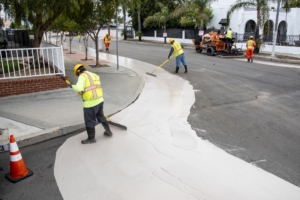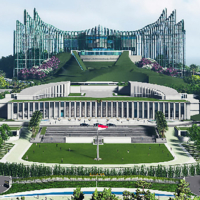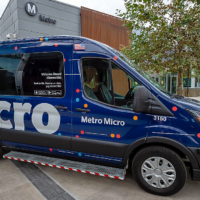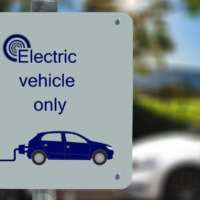
On-the-Ground Guidance for L.A.’s Far-Reaching Climate Strategy University researchers and a robot named MaRTy complete first on-site test of city’s Cool Streets program
By Mary Braswell
Los Angeles’ ambitious plan to cool the city as the planet grows warmer is getting a boost from two university professors and a street-smart robot named MaRTy.
The researchers, from UCLA and Arizona State University, have completed the first on-site evaluation of the city’s Cool Streets program, one of several sustainability strategies outlined in Los Angeles’ 2019 Green New Deal.
By covering several blocks of road with a solar-reflective coating engineered to reduce surface temperatures, the city’s pilot program aims to test the cooling effects on an entire neighborhood. The researchers broadened the body of knowledge by collecting a sophisticated suite of measurements that simulate the experience of a pedestrian walking on the surface.
“Once you take things down to the street level, arguably you have to start thinking about the thermal load on people,” said V. Kelly Turner of the UCLA Luskin School of Public Affairs, who collaborated with Ariane Middel of ASU’s School of Arts, Media and Engineering.
The reflective coating aims to prevent asphalt from retaining heat, which contributes to the “urban heat island effect” that keeps cities from cooling down, even in the evening. But the study by Turner and Middel, newly published in the journal Environmental Research Letters, reveals an unintended, ground-level effect: The paint’s highly reflective properties can actually elevate pedestrians’ exposure to heat.
Imagine a scene that has become increasingly common as Angelenos shelter in place: families taking neighborhood walks, often with a dog in tow. On a coated road, the dog might appreciate the cooler surface beneath its paws. But the dog walkers might feel an uptick in heat reflected off the ground.

City workers apply a cooling paint on roads in Pacoima, part of Los Angeles’ strategy to combat climate change. Photo courtesy of Los Angeles Bureau of Street Services
“From an urban planning perspective, this idea of cool pavements is really innovative. Cool streets may be great for mitigating the urban heat island, if that’s the goal,” said Turner, who noted that the widespread use of the reflective paint on roofs, roads and other surfaces can reduce the amount of heat absorbed in the built environment.
However, she added, “If the goal is framed in terms of a public health benefit, we need to know a bit more, since the reflected radiation increases the heat load on a pedestrian walking over the surface.”
Turner and Middel hope their initial findings will open the door to further research that will help the public and private sectors fine-tune their green initiatives. In addition to gathering more information about cooling paint’s impact on human comfort and health, future studies could answer questions about cost-effectiveness, maintenance needs and the tradeoff between daytime glare and nighttime visibility, they said.
Putting MaRTy into action
To collect their cool pavement data, Turner and Middel took MaRTy for a spin on the streets of two Los Angeles neighborhoods chosen for the pilot project.
The robot is “essentially a garden cart that has a lot of meteorological sensors attached to it,” said Middel, who created the tool at ASU’s SHaDE Lab to calculate “mean radiant temperature” — the data set that gives MaRTy his name.
In addition to measuring surface and air temperature, wind speed and humidity, the robot collects information on long- and short-wave radiation to determine mean radiant temperature, which is a reliable predictor of thermal comfort for humans. MaRTy is also nimble enough to trundle along sidewalks, ravines or other locations where a pedestrian might wander, setting him apart from measurement tools mounted on street vehicles.
On a day in July 2019 when air temperatures hit the high 80s, the research team walked the blocks of the two neighborhoods, in Pacoima and Sun Valley, from 11 a.m. to 9 p.m. They found that the coated roadways were cooler to the touch, by as much as 11 degrees Fahrenheit, compared with nearby untreated asphalt — meaning the paint successfully lowered surface temperature, as it was designed to.
However, Turner and Middel also discovered that mean radiant temperatures at midday were more than 7 degrees Fahrenheit warmer in a five-foot–high area above the cool surfaces, compared with asphalt. In the midafternoon, that number fell to about 3 degrees.
While Los Angeles’ Cool Streets program targets roads designed for cars rather than people, the study provides useful data for agencies considering the cooling paint for playgrounds or other pedestrian areas.
Turner and Middel say the findings will also inform their separate, ongoing study supporting California’s Transformative Climate Communities program, which invests in climate action at the local level. Both of the researchers’ projects were underwritten by the UCLA Luskin Center for Innovation, where Turner is associate director of urban environment research.
Greg Spotts, chief sustainability officer for Los Angeles’ Bureau of Street Services, said he welcomes the on-the-ground findings produced by Turner, Middel and MaRTy and called for further study.
“By being the first municipality in California, and possibly the country, to deploy a cool pavement coating on a public street, we now have physical sites where researchers can do some of their work. Before, most of the research was based on computer modeling,” he said.
Spotts, who earned his master’s in public policy at UCLA Luskin in 2008, spearheaded the cool pavement project as one part of a multipronged strategy to combat climate change at the neighborhood level. To date, the Bureau of Street Services has planted trees, built shade structures and installed hydration stations, among other interventions.
Future research could explore how cool pavement works in combination with these complementary measures to reduce the overall heat island effect on a community scale while also increasing pedestrian thermal comfort at the street level.
Turner and Middel concurred that climate change must be tackled from multiple directions.
“There is not just one solution that’s going to solve all our problems,” Middel said. “We have to look at the benefits and tradeoffs of all the solutions we’re considering to come up with the best way to cool our cities.”







Leave a Reply
Want to join the discussion?Feel free to contribute!